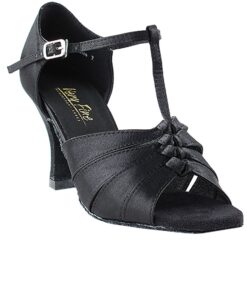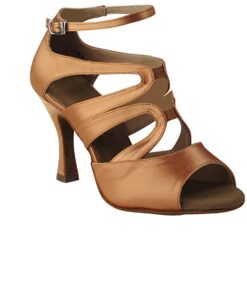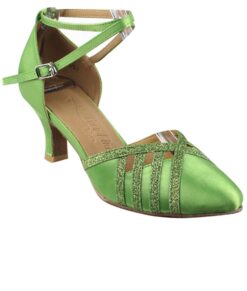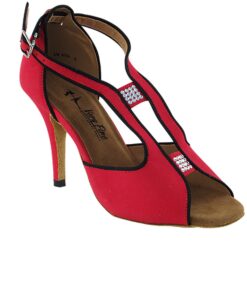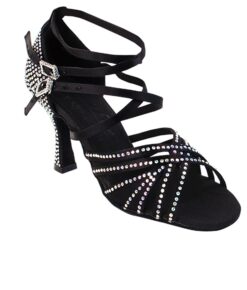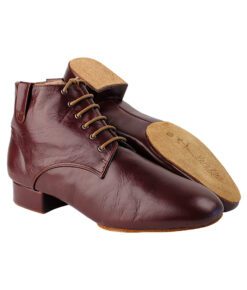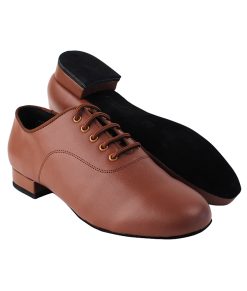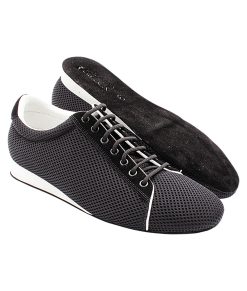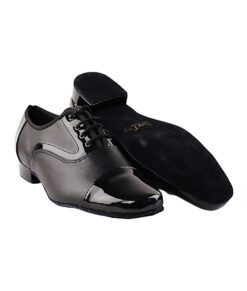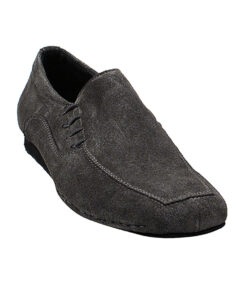Shoe Care & Fit Essentials
8 Effective Tips to Break in Ballroom Dance Shoes Besides Dancing in Them
Introduction: Why Breaking in Dance Shoes is Crucial
Breaking in dance shoes before using them in long rehearsals or performances is an essential step for any dancer. Properly broken-in dance shoes can significantly enhance comfort and performance, mitigating the risk of blisters, sores, and other injuries that often stem from stiff, new footwear. When dance shoes are adequately broken in, they mold to the dancer’s feet, providing better support and flexibility, which is crucial for executing intricate movements and maintaining balance.
The benefits of breaking in dance shoes extend beyond comfort. Improperly conditioned shoes can lead to not only immediate discomfort but also the potential for long-term foot issues, influencing overall performance negatively. A well-conformed shoe aids in absorbing shocks and reducing the strain on the feet and ankles, enabling dancers to perform with finesse and ease.
Moreover, the longevity of dance shoes is closely linked to how well they are broken in. New shoes can be particularly stiff, which increases the likelihood of material damage when subjected to rigorous use without proper preparation. By taking the time to carefully break in dance shoes, their durability is enhanced, making them a more reliable companion through many rehearsals and performances.
While dancing is the most natural way to break in shoes, there are numerous alternative techniques to expedite the process without having to dance in them. These methods ensure that the shoes attain the required flexibility and fit, allowing for an uncompromised performance from the get-go. This blog will explore 10 practical tips beyond dancing that will help dancers to break in their shoes effectively, ensuring comfort, performance, and durability.
Tip 1: Use a Shoe Stretcher
One of the most effective ways to break in dance shoes, besides dancing in them, is by using a shoe stretcher specifically designed for this purpose. The different types of shoe stretchers include manual and electric versions, each with distinctive benefits. A manual shoe stretcher requires physical adjustment by turning a knob or handle to expand the shoe’s length and width. In contrast, an electric shoe stretcher performs the same function automatically, offering greater convenience and often more precise control over the degree of stretching.
Whether you choose a manual or electric shoe stretcher, the process is straightforward. Prior to stretching, it may be beneficial to slightly dampen the interior of the shoe with a shoe-stretching spray or water, making the material more pliable. Insert the shoe stretcher into the dance shoe and adjust it according to the instructions provided by the manufacturer. For manual models, turn the handle to gradually expand the stretcher until it fills the interior of the shoe, focusing on areas that feel tight. Electric models will require you to set the desired dimensions before switching on the device.
Shoe stretchers can provide relief by gradually expanding both the length and width of the shoe, making it more suitable to your foot shape. It is important to use the shoe stretcher in intervals, typically for a few hours at a time, repeating the process until the shoes reach the desired comfort level. Overuse within a short period may overstretch the material, compromising the shoe’s structure and durability.
Using a shoe stretcher on your dance shoes can yield excellent results, especially when performed regularly. By alternating the stretching sessions with periods of rest, you can achieve a more comfortable and well-fitted pair of dance shoes without the need to endure prolonged discomfort on the dance floor.
Tip 2: Warm Your Shoes Before Wearing
One effective strategy to accelerate the break-in process of your dance shoes is to warm them up before wearing. Utilizing a hairdryer or a warm towel can be particularly beneficial in this regard. The application of heat helps make the shoe material more pliable, allowing it to mold to the contours of your foot more quickly.
To employ this method safely, start by gently warming the shoes with a hairdryer. Keep the dryer on a low to medium heat setting and maintain at least a six-inch distance from the shoes to prevent overheating. Focus on the areas that are particularly stiff or tight. Alternatively, you can use a warm towel. Simply heat the towel in a microwave for a few seconds and then wrap it around your shoes for a short period. This indirect heat achieves the same result without the risk of direct exposure.
It is crucial to exercise caution to avoid damaging your dance shoes. Never expose your shoes to excessive heat, as this can weaken the adhesive and stitching that hold them together. Additionally, avoid prolonged heating sessions, and always monitor the process to ensure the material does not become overly hot. These precautions help in safely making the material more flexible, thus expediting the break-in stage.
Warming your dance shoes is a practical and efficient approach to achieving that perfect fit. When done correctly, this technique can reduce the discomfort often associated with new dance shoes, ensuring you can focus more on your movements and less on the fit of your footwear. Incorporate this method as part of your regular pre-dance preparations to keep your feet comfortable and your performance flawless.
Tip 3: Wear Thicker Socks
One effective method for breaking in dance shoes is to wear thicker socks or multiple layers of socks. This strategy can accelerate the process of stretching the material and achieving a more comfortable fit. The added layers create extra padding that helps to exert gentle pressure on the shoe, encouraging the material to mold more quickly to the shape of your feet.
The benefit of wearing thicker socks lies in the balance between stretching the shoes and cushioning your feet. The additional padding can absorb some of the initial rigidity and discomfort often associated with new dance shoes. This method is particularly useful for materials that adapt well to stretching, such as leather or certain synthetics.
To effectively use this technique, it is recommended to wear your dance shoes with thicker socks for short periods initially, gradually increasing the duration as the shoes begin to give. Start with around 30 minutes to an hour of wearing them around the house, preferably during activities that involve some walking. Continue this practice daily or as frequently as possible until you notice an improvement in the fit and comfort of the shoes. Extending the wearing time incrementally allows the shoes to adjust without causing undue strain on your feet.
Incorporating thicker socks as part of your shoe-break-in routine not only makes the shoes more pliable but also provides an added layer of protection against potential blisters or pressure points. Continuous and consistent practice will result in a more customized fit, enhancing both comfort and performance when it comes time to dance.
Tip 4: Use Moisturizers or Conditioners
One effective method to break in dance shoes without dancing in them is by applying leather conditioners or moisturizers. These products soften the material, making it more flexible and comfortable to wear. Various products are available for different types of dance shoes, including ballet, jazz, and ballroom shoes.
For leather dance shoes, it’s advisable to use a leather conditioner specifically designed for footwear. Popular choices include products like Lexol Leather Conditioner and Fiebing’s Leather Conditioner, which are known for their ability to deeply penetrate the leather and maintain its flexibility. To apply these conditioners, first, clean the shoes with a damp cloth to remove any dirt or dust. Once the shoes are clean, take a small amount of conditioner on a soft, dry cloth and rub it gently over the leather surface in a circular motion. Ensure even coverage and allow the conditioner to be absorbed for at least an hour before wiping off any excess with a clean cloth.
Suede dance shoes require a different approach. For these, use a suede conditioner or protector, such as the Moneysworth & Best Suede and Nubuck Cleaner/Conditioner. Suede’s delicate texture requires a more cautious application. Use a soft-bristled brush to clean the shoes first, then apply a light coat of the conditioner, allowing it to soak in. Avoid over-applying, which can lead to a greasy appearance.
For synthetic or fabric dance shoes, options such as multi-purpose fabric conditioners or sprays can be used. Ensure the product is suitable for the shoe material to avoid damage. A small patch test on an inconspicuous area of the shoe is recommended before full application. Like with leather and suede, clean the shoes first, then apply the moisturizer lightly and evenly.
Precautions are essential when using these products: test on a small area, follow the instructions on the product label, and avoid over-application. Proper application of moisturizers or conditioners can significantly improve the flexibility and comfort of your dance shoes, ensuring they perform optimally during use.
Tip 5: Flex and Bend the Shoes Gently
Breaking in dance shoes can be a delicate process, requiring patience and precision to ensure the shoes become supple without incurring damage. One effective technique is to flex and bend the shoes gently by hand. This method softens the material, enhancing comfort and performance during practice and performances.
To begin, take the shoes in your hands, grip them firmly but gently at the toe and heel. Apply a slight bend, rolling the shoes in both directions – forwards and backwards. This motion mimics the natural movements of the foot and helps the material to adapt more quickly. To avoid undue stress on the shoes, apply consistent yet gentle pressure.
Another technique involves a careful twisting motion. Hold the shoe at the toe and the heel, and gently twist in opposite directions. Repeat the twist, alternating directions slowly and methodically. This softens the rigidity of the sole and allows the shoe to mold more naturally to the shape of your foot.
While executing these maneuvers, it’s imperative to maintain a level of gentleness. Excessive force can damage the shoe’s structure, leading to a reduced lifespan and compromised safety during use. Instead, aim for a steady modulating force that incrementally eases the shoe into a more flexible state.
For shoes made from particularly stiff materials, consider using a warm cloth to gently heat specific areas before flexing. This can make the material more pliable and responsive to your movements. However, avoid applying direct heat, as this can degrade the fabric or adhesive properties of the shoe.
Incorporating these careful flexing exercises into your routine will help pre-condition your dance shoes, enhancing their comfort and fit without accelerating wear and tear, thus ensuring they support you optimally in every performance.
Tip 6: Walk Around the House
Another effective way to break in dance shoes, beyond dancing in them, is to wear them around the house. This approach provides an excellent opportunity for your shoes to gradually adapt to the shape of your feet. By wearing them in a controlled environment, you alleviate the intense wear and tear often associated with dancing.
Start by wearing your dance shoes for short, manageable periods. Initially, try wearing them for about 10 to 15 minutes at a time. As your shoes start to conform to your feet, you can gradually increase the duration. The key is to allow for a gradual adjustment without causing unnecessary discomfort or prematurely damaging the shoes.
Frequency is also essential in this breaking-in process. Consistency will enable the shoes to acclimate more effectively. Aim to wear the shoes around the house daily for the initial week. Simple activities such as walking from room to room, climbing stairs, or standing while doing household chores can make a significant difference in the break-in period. The natural movements of walking allow the dance shoes to mold more closely to the contours of your feet, leading to a more comfortable and personalized fit.
Additionally, it’s advisable to monitor any discomfort during this period. If you experience persistent pain or pressure points, consider making minor adjustments, such as loosening the laces or straps. This will make the process more comfortable and reduce the risk of developing blisters or sore spots.
Integrating these practices into your routine ensures that your dance shoes are progressively broken in without excessive strain. This method strikes a balance between comfort and effectiveness, making it a reliable strategy for any dancer looking to perfect their shoes before hitting the dance floor.
Tip 7: Use a Damp Cloth or Spray
One effective method for breaking in dance shoes without subjecting them to rigorous wear involves using a damp cloth or a light mist of water. When used appropriately, this technique can help soften the material, making the shoes more flexible and comfortable. The key is to create a controlled environment where the moisture assists in gently loosening the fibers, facilitating an easier break-in process.
To employ this method, first, lightly dampen a cloth with water and apply it to the interior surfaces of the shoes, ensuring to cover areas where the material feels particularly stiff. Alternatively, you can use a spray bottle to mist the inside of the shoes evenly. The goal is to introduce just enough moisture to impact the material without causing saturation. Understanding the balance is critical; a light touch will yield results without the risk of overdoing it.
After dampening the interiors, wear the shoes and move around in them until they dry completely. By doing so, you enable the shoes to conform more precisely to the shape of your feet as they dry, enhancing comfort and fit. This process not only helps in breaking in the shoes but also aids in reducing potential pressure points and discomfort during actual dance routines.
However, it is paramount to exercise caution with this technique. Avoid over-soaking the shoes, as excessive water can lead to damage, potentially compromising both the integrity and longevity of the material. Overdampening can also result in undesirable odors and could deform the shoes altogether. Always proceed with moderation, keeping the moisture application light and controlled.
Using a damp cloth or a fine mist of water is a practical approach to ease the break-in period for new dance shoes. When executed with care, it can efficiently soften the material, promote a better fit, and ultimately enrich your dancing experience by ensuring your shoes provide both comfort and flexibility.
Tip 8: Patience and Gradual Use
Breaking in dance shoes is a meticulous process that demands significant patience and gradual use. Unlike everyday footwear, dance shoes require a period of acclimatization to conform adequately to the dancer’s feet, ensuring both comfort and performance. The temptation to rush this process is certainly understandable; however, doing so not only risks damaging the shoes but also invites potential injury to the dancer.
Slow and steady incremental usage of dance shoes allows the material to soften and mold naturally to your feet. Consider wearing your new dance shoes for short, controlled periods during practice sessions. Start by using them for 20-30 minutes, gradually increasing the duration as the shoes begin to take the shape of your feet. This methodical approach prevents abrupt stress on the shoe material and on your feet.
Integrating this gradual use with the other techniques mentioned, such as using shoe stretchers or applying leather conditioners, can optimize the break-in process. For example, wearing the shoes with thick socks can provide immediate comfort and speed up the stretching process without overburdening the shoes. Remember, the break-in phase is not just about making the shoes fit better but also about allowing your feet to adapt to the shoes’ structure and support features progressively.
Persisting through this gradual break-in period ensures a comfortable fit and preserves the lifespan of your dance shoes. Arriving at a well-fitted pair is a gradual journey, not a sprint. Embrace the process with the understanding that well-broken-in shoes will significantly enhance your dancing experience, offering both support and flexibility. Patience in breaking in your dance shoes ultimately translates into a harmony of comfort and performance on the dance floor.



